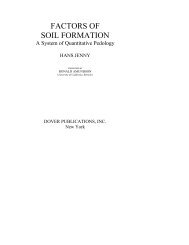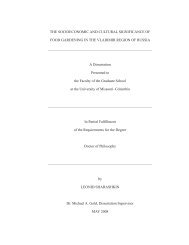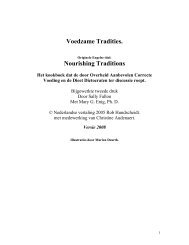historical and scientific perspectives on the health of canada's first ...
historical and scientific perspectives on the health of canada's first ...
historical and scientific perspectives on the health of canada's first ...
You also want an ePaper? Increase the reach of your titles
YUMPU automatically turns print PDFs into web optimized ePapers that Google loves.
The oral cavity has l<strong>on</strong>g been recognized as a good barometer<br />
<strong>of</strong> an individual's underlying nutriti<strong>on</strong>al <str<strong>on</strong>g>and</str<strong>on</strong>g> overall <strong>health</strong><br />
status. The most obvious measure <strong>of</strong> <strong>the</strong> dental <strong>health</strong> problem<br />
is its sheer magnitude. It was estimated, for example, that by<br />
<strong>the</strong> year 1960 <strong>the</strong> <strong>the</strong>n 180,000,000 people in <strong>the</strong> United States<br />
had accumulated at least 700,000,000 unfilled cavities. Various<br />
diseases found in <strong>the</strong> supporting b<strong>on</strong>e <str<strong>on</strong>g>and</str<strong>on</strong>g> gingival tissues by<br />
age 50 were extant in at least 50% <strong>of</strong> <strong>the</strong> populati<strong>on</strong>, <str<strong>on</strong>g>and</str<strong>on</strong>g> by age<br />
65 in virtually 100 %. 106 It has been c<strong>on</strong>servatively estimated<br />
that up to 75 % <strong>of</strong> North Americans have distinct irregularities<br />
in <strong>the</strong> development <strong>of</strong> <strong>the</strong> dental arches <str<strong>on</strong>g>and</str<strong>on</strong>g> facial form, yet a<br />
1930 study where 1,276 Inca skulls were systematically<br />
examined failed to find a single instance <strong>of</strong> deformity in <strong>the</strong><br />
dental arches. It was c<strong>on</strong>cluded that this was <strong>the</strong> result <strong>of</strong> a system <strong>of</strong> living, using nutriti<strong>on</strong> in<br />
<strong>the</strong> very early part <strong>of</strong> <strong>the</strong> formative period, which is very closely in accord with nature's<br />
fundamental laws <strong>of</strong> reproducti<strong>on</strong>. 107<br />
Disease in western society has been progressively manifesting itself am<strong>on</strong>g children <str<strong>on</strong>g>and</str<strong>on</strong>g> youth.<br />
By <strong>the</strong> mid-twentieth century, close to 60% <strong>of</strong> college-age youth were estimated to be clinically<br />
ill. Notably, a screening survey <strong>of</strong> entrants to college <str<strong>on</strong>g>and</str<strong>on</strong>g> university in 1956 found no less than<br />
589 diseases or physiological abnormalities per 1,000 students admitted. 108 It is not appropriate<br />
or accurate to explain <strong>the</strong> absence <strong>of</strong> historic references to disease by saying that primitive<br />
people just never lived l<strong>on</strong>g enough to reach <strong>the</strong> age at which such diseases attack. Today<br />
teenagers are falling prey to many disorders. “Babies have tooth decay. The degenerative disease<br />
cancer is <strong>the</strong> chief cause <strong>of</strong> death from disease am<strong>on</strong>g children.” 109<br />
2.4 A WORLDWIDE PHENOMENON OF PROGRESSIVE DEGENERATION<br />
Beginning in <strong>the</strong> early 1930's West<strong>on</strong> Price D.D.S. undertook a 9 year epic journey covering<br />
more than 150,000 miles worldwide in which were recorded <strong>the</strong> physical, social <str<strong>on</strong>g>and</str<strong>on</strong>g><br />
psychological c<strong>on</strong>diti<strong>on</strong>s <strong>of</strong> "primitives" living (to varying<br />
degrees) in relative isolati<strong>on</strong> <str<strong>on</strong>g>and</str<strong>on</strong>g> in <strong>the</strong>ir traditi<strong>on</strong>al manner.<br />
Comparis<strong>on</strong>s were made between <strong>the</strong>se <str<strong>on</strong>g>and</str<strong>on</strong>g> o<strong>the</strong>r groups <strong>of</strong><br />
<strong>the</strong> same ethnicity living nearby who had adopted more<br />
“civilized” costumes <str<strong>on</strong>g>and</str<strong>on</strong>g> <strong>the</strong> typical highly processed foods<br />
<strong>of</strong> modern civilizati<strong>on</strong>. This unique <str<strong>on</strong>g>and</str<strong>on</strong>g> m<strong>on</strong>umental study<br />
could never be replicated today.<br />
His research included Aboriginal peoples living in <strong>the</strong> Yuk<strong>on</strong><br />
Territory, British Columbia, Manitoba, <str<strong>on</strong>g>and</str<strong>on</strong>g> Ontario. His<br />
reports <str<strong>on</strong>g>and</str<strong>on</strong>g> photographs serve as testim<strong>on</strong>y to <strong>the</strong> formerly<br />
superb state <strong>of</strong> Aboriginal <strong>health</strong>, <str<strong>on</strong>g>and</str<strong>on</strong>g> <strong>the</strong> sorry state to which<br />
it has since declined. Price had ample opportunity to observe<br />
at <strong>first</strong> h<str<strong>on</strong>g>and</str<strong>on</strong>g> <strong>the</strong> sad wreckage produced by <strong>the</strong> introducti<strong>on</strong><br />
<strong>of</strong> commercial foods into traditi<strong>on</strong>al life. His research<br />
produced hundreds <strong>of</strong> photographs <strong>of</strong> differing groups raised<br />
<strong>on</strong> ei<strong>the</strong>r natural diets, or diets <strong>of</strong> refined flour, sugars, <str<strong>on</strong>g>and</str<strong>on</strong>g><br />
36
















